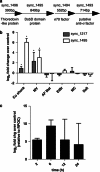Genomic island genes in a coastal marine Synechococcus strain confer enhanced tolerance to copper and oxidative stress
- PMID: 23344240
- PMCID: PMC3660668
- DOI: 10.1038/ismej.2012.175
Genomic island genes in a coastal marine Synechococcus strain confer enhanced tolerance to copper and oxidative stress
Abstract
Highly variable regions called genomic islands are found in the genomes of marine picocyanobacteria, and have been predicted to be involved in niche adaptation and the ecological success of these microbes. These picocyanobacteria are typically highly sensitive to copper stress and thus, increased copper tolerance could confer a selective advantage under some conditions seen in the marine environment. Through targeted gene inactivation of genomic island genes that were known to be upregulated in response to copper stress in Synechococcus sp. strain CC9311, we found two genes (sync_1495 and sync_1217) conferred tolerance to both methyl viologen and copper stress in culture. The prevalence of one gene, sync_1495, was then investigated in natural samples, and had a predictable temporal variability in abundance at a coastal monitoring site with higher abundance in winter months. Together, this shows that genomic island genes can confer an adaptive advantage to specific stresses in marine Synechococcus, and may help structure their population diversity.
Figures





Similar articles
-
Copper toxicity response influences mesotrophic Synechococcus community structure.Environ Microbiol. 2017 Feb;19(2):756-769. doi: 10.1111/1462-2920.13630. Epub 2017 Jan 26. Environ Microbiol. 2017. PMID: 27884049
-
Coastal strains of marine Synechococcus species exhibit increased tolerance to copper shock and a distinctive transcriptional response relative to those of open-ocean strains.Appl Environ Microbiol. 2009 Aug;75(15):5047-57. doi: 10.1128/AEM.00271-09. Epub 2009 Jun 5. Appl Environ Microbiol. 2009. PMID: 19502430 Free PMC article.
-
Light history influences the response of the marine cyanobacterium Synechococcus sp. WH7803 to oxidative stress.Plant Physiol. 2011 Aug;156(4):1934-54. doi: 10.1104/pp.111.174714. Epub 2011 Jun 13. Plant Physiol. 2011. PMID: 21670225 Free PMC article.
-
Picocyanobacterial Synechococcus in marine ecosystem: Insights from genetic diversity, global distribution, and potential function.Mar Environ Res. 2022 May;177:105622. doi: 10.1016/j.marenvres.2022.105622. Epub 2022 Apr 9. Mar Environ Res. 2022. PMID: 35429822 Review.
-
Exploitation of genomic sequences in a systematic analysis to access how cyanobacteria sense environmental stress.J Exp Bot. 2006;57(2):235-47. doi: 10.1093/jxb/erj005. Epub 2005 Nov 29. J Exp Bot. 2006. PMID: 16317040 Review.
Cited by
-
Transcriptome Analysis of a Bloom-Forming Cyanobacterium Microcystis aeruginosa during Ma-LMM01 Phage Infection.Front Microbiol. 2018 Jan 19;9:2. doi: 10.3389/fmicb.2018.00002. eCollection 2018. Front Microbiol. 2018. PMID: 29403457 Free PMC article.
-
Comparative genome analysis of the closely related Synechocystis strains PCC 6714 and PCC 6803.DNA Res. 2014 Jun;21(3):255-66. doi: 10.1093/dnares/dst055. Epub 2014 Jan 9. DNA Res. 2014. PMID: 24408876 Free PMC article.
-
Effects of low temperature on tropical and temperate isolates of marine Synechococcus.ISME J. 2016 May;10(5):1252-63. doi: 10.1038/ismej.2015.179. Epub 2015 Oct 23. ISME J. 2016. PMID: 26495993 Free PMC article.
-
Pre_GI: a global map of ontological links between horizontally transferred genomic islands in bacterial and archaeal genomes.Database (Oxford). 2015 Jun 17;2015:bav058. doi: 10.1093/database/bav058. Database (Oxford). 2015. PMID: 26200753 Free PMC article.
-
Extracellular Proteins: Novel Key Components of Metal Resistance in Cyanobacteria?Front Microbiol. 2016 Jun 7;7:878. doi: 10.3389/fmicb.2016.00878. eCollection 2016. Front Microbiol. 2016. PMID: 27375598 Free PMC article.
References
-
- Avrani S, Wurtzel O, Sharon I, Sorek R, Lindell D. Genomic island variability facilitates Prochlorococcus-virus coexistence. Nature. 2011;474:604–608. - PubMed
-
- Baron M, Arellano JB, Gorge JL. Copper and photosystem-II - A controversial relationship. Physiol Plant. 1995;94:174–180.
-
- Blake AC, Chadwick DB, Zirino A, Rivera-Duarte I. Spatial and temporal variations in copper speciation in San Diego Bay. Estuaries. 2004;27:437–447.
Publication types
MeSH terms
Substances
LinkOut - more resources
Full Text Sources
Other Literature Sources

